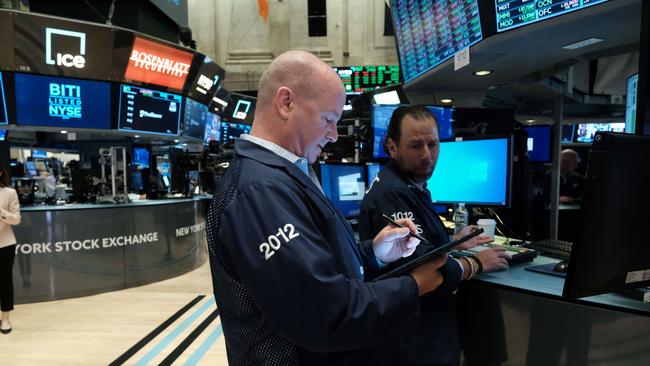US stocks finish higher after worst start to year in decades
Treasury yields extend recent decline; S&P 500 down for 11 weeks in the past 13.

Bond yields sank and stocks recovered a fraction of their weekly losses on Friday, kicking off the back half of a year that more investors fear could be marred by a slowing economy.
A day after closing out the index’s worst first half of any year since 1970, the S&P 500 on Friday clawed its way into the green after early losses but still finished the week down 2.2%. It has now fallen for 11 of the past 13 weeks.
Government-bond yields slumped, continuing a retreat from mid-June highs, as traders considered whether the Federal Reserve might ease away from its aggressive path of interest-rate increases in the months ahead.
The fall in Treasury yields is a pivot point for investors’ outlooks, said Roger Aliaga-Diaz, chief economist for the Americas at Vanguard. Traders favor Treasury bonds for their ultrasafe returns in the face of economic distress, but sell them when rising prices augur higher benchmark interest rates set by the Fed. A bond’s yield falls as its price rises.
“For much of this year, Treasury yields went up very quickly as the Fed was responding to inflation concerns,” Mr. Aliaga-Diaz said. “I suspect that has started impacting the growth of the economy.”
On Friday, at least, stocks reversed some of their recent declines. The S&P 500 gained 39.95 points, or 1.1%, to 3825.33. The tech-focused Nasdaq Composite Index rose 99.11 points, or 0.9%, to 11127.85. The Dow Jones Industrial Average climbed 321.83 points, or 1%, to 31097.26.
Still, investors have carried a risk-averse mood into the summer. On a shortened day for bond trading ahead of the holiday weekend, the yield on the 10-year Treasury note fell to 2.901% from 2.973%. On June 14, it had peaked near 3.5%. U.S. markets will be closed Monday for the Fourth of July.
Panic-resistant stocks such as utilities and consumer staples ended the week ahead, while tech companies and consumer-discretionary businesses led the week’s losses.
“When we see defensive sectors outperforming more economically sensitive sectors, that tends to tell us that investors are focused on the growing risk of a recession relative to a soft landing,” said Joshua Jamner of ClearBridge Investments.
Even as growth slows, investors remain wary of persistent inflation, which has forced central banks to reverse years of easy-money policies and accelerate interest-rate increases. That has created challenging conditions for markets, because fast-rising prices make it harder for Fed officials to soothe growth concerns with looser monetary policy. Central-bank officials world-wide have signaled that they are more concerned about taming inflation than an economic slowdown.
“If the inflation fever begins to break a little bit here, it would give the Fed more breathing room,” said Jurrien Timmer, director of global macro at Fidelity Investments. “That could be enough to calm the economy down without causing much collateral damage.”
Earlier Friday, markets swung lower after the Institute for Supply Management’s report on U.S. factories showed that manufacturing activity decelerated in June. Data released this week showed U.S. household spending slowed in May.
“We can see the foundations are being set for a recession,” said Seema Shah, chief strategist at Principal Global Investors. She expects to see a recession at the start of next year if the labor market weakens. Fresh employment data is due July 8.
The war in Ukraine and uncertainty over the pace of future oil production make it difficult to assess the path for inflation and the prospect of recession, she said.
Elevated energy prices have been a key component of higher inflation. Brent crude, the international benchmark for oil prices, rose $2.60 on Friday, or 2.4% to $111.63 a barrel.
Anxiety has also entered corporate-bond markets. The premiums investors demand to hold the debt of highly rated companies instead of Treasury bonds have now risen to their highest level since the first months of the Covid-19 pandemic in 2020, according to Bloomberg index data.
Interest-rate volatility has slowed new bond sales. Investment-grade companies issued about $68 billion of new bonds last month, the smallest June total in nine years, according to BMO Capital Markets analysts.
With the S&P 500 in a bear market, defined as a 20% fall from a recent high, stock investors have been weighing how individual companies will fare amid the cloudy outlook for the second half of 2022. Midway through this month, a parade of big businesses will begin unveiling their second-quarter financial results, giving investors a look at recent performance.
Micron Technology shares fell $1.63, or 3%, to $53.65 on Friday after the memory-chip maker issued a subdued revenue outlook, spooking investors even as it reported a strong rise in earnings for its latest quarter. Shares of Kohl’s fell $7.01, or 20%, to $28.68 after the retailer said that takeover talks with Franchise Group ended without a deal.
General Motors stock climbed 43 cents, or 1.4%, to $32.19 after the auto maker stood by its full-year guidance, despite warning that production challenges will weigh on second-quarter results. GM said that about 95,000 vehicles were built without certain semiconductors due to global shortages and can’t be shipped to dealers yet.
Bitcoin, the world’s largest cryptocurrency by market value, continued to trade below $20,000 as concerns about the safety of digital assets persisted. Bitcoin’s price had surpassed $60,000 at its peak last November.
Overseas, the pan-continental Stoxx Europe 600 finished about flat. The European Union’s statistics agency said Friday that inflation in the eurozone rose to a record high in June.In Asia, major indexes closed with losses. Japan’s Nikkei 225 declined 1.7%, while South Korea’s Kospi fell 1.2%. China’s Shanghai Composite edged 0.3% lower. Hong Kong’s Hang Seng was closed for a holiday.
The Wall Street Journal


